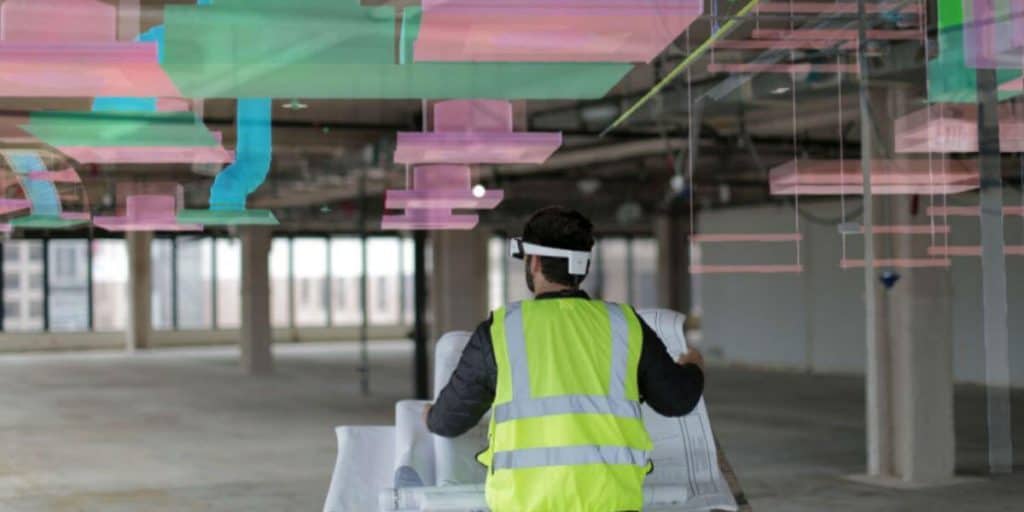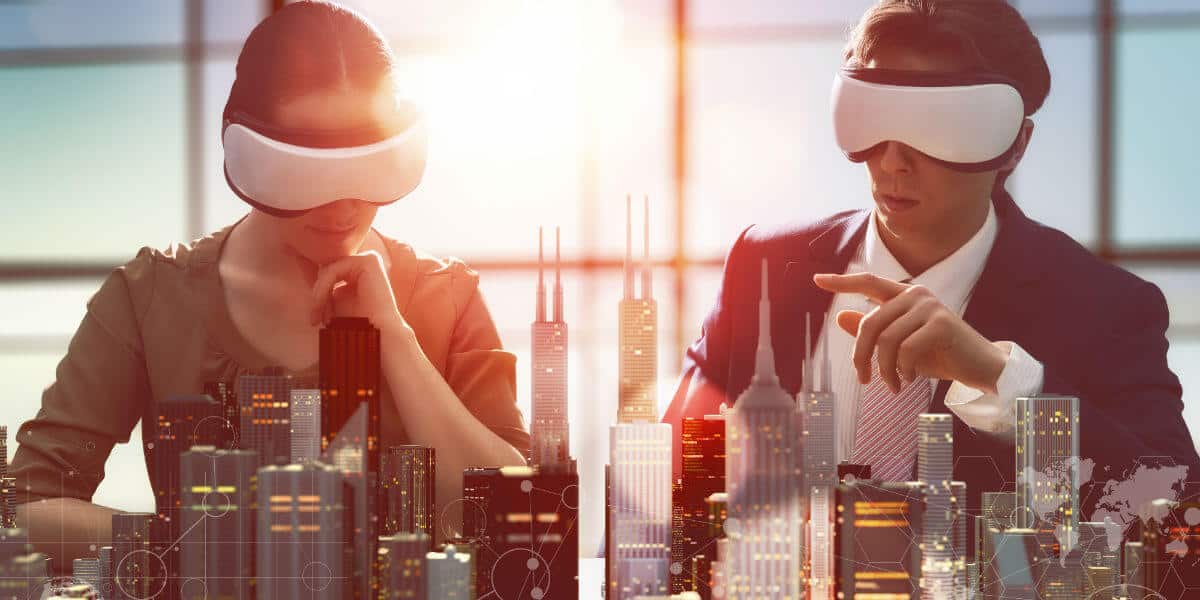Virtual Reality (VR) and Augmented Reality (AR) have the potential to play a significant role in the building industry in the coming years. While their use has been slow to be implemented, partly due to cost, the technology provides advantages that could significantly impact the fields of design and construction.
The design professions, Architects, in particular, have been quicker to implement the use of virtual reality mainly because it provides an excellent platform to display their visions to clients. In recent times, Architects have relied on technologies such as 3D modeling and digital true-to-life renderings to showcase their designs.
While these methods can show a great deal, particularly with the ability of 3D modeling to simulate walkthroughs and pan and move around the virtual models, one component is missing in these presentations that virtual reality can provide. The ability for the user to move and experience the space in any way they choose. In other words, an environment where the user dictates movement through space, not the designer.
Most VR design applications today are desktop virtual reality presentations. The user can view and interact with the computer-presented image on a traditional computer graphic screen. However, fully immersive virtual reality takes this a step further by replacing the screen with a head-mounted display unit. The following are six ways virtual and augmented reality could impact the building industry in the future.
1. Learn from Users How Spaces are Likely to be Experienced
Simulated walkthroughs using virtual reality have the potential to provide a great deal of information to the design team on how occupants are likely to use a space. The findings may very well differ from how the designer had envisioned the space being used in terms of circulation, vertical transportation, and focal points within the space.
A greater degree of interaction can take place during the conceptual phases between the designer and the user. Spaces may feel too small or too large when the client has the chance to walk through. The user can identify rooms they would like added or spaces that are unnecessary.
The more information that can be input into the virtual model in terms of architectural features and structural, mechanical, plumbing, lighting, etc., the more informed the interaction can be between the user and the designer.
Taking the concept of user experience a step further; the technology has the ability to inform the design and code consulting teams a great deal about how the user experience impacts code-related issues such as egress out of a building or accessibility.
2. Perform risk assessment in buildings during the design stages
Identifying and assessing any code-related issues related to egress and fire safety could end up being a vital component of virtual reality simulation. A lot could be learned from how people evacuate spaces in simulated emergencies.
Code Consultants, specialized in testing out virtual environments, could learn valuable information from walking through the spaces in a virtual setting. This, in turn, could help identify areas of improvement early on in the design phases when they can still be adjusted.
Even in the late stages of design or after a building has been completed, the potential to simulate evacuations in emergencies could be a significant benefit of the technology. Training building occupants in virtual environments could help better prepare them before the actual situation arrives.
Augmented reality, which differs from virtual reality in that it combines real-life environments with an overlay of virtual technology (Google Glass is an example of this technology), can play a significant role in evacuation drills once a building has been completed.
Augmented reality has the advantage of being able to instruct occupants during practice drills so that they not only experience the real setting but are guided by smart technology on what action to take and which direction to go in the event of various scenarios.

3. Identify conflicts between design profession layouts early on
With the introduction of building information modeling (BIM), a major step forward was taken in the identification of layout conflicts between the various professions involved in building design.
Virtual reality has the potential to take this information to the next level. By being able to walk through virtual spaces, conflicts should be more easily identifiable so that they can be adjusted early on. It is easier to spot these issues when experiencing spaces in real-life-like settings.
Not only are these major steps forward in terms of coordination, but they could save considerable costs on projects. These issues are often not identified until during construction. Early identification should help avoid costly redesigns during the construction phase.
4. Allow the construction team to become involved earlier in projects during the design stages
Along the same lines, virtual reality can allow the construction team to become involved earlier in the design phases of a project. Contractors can provide added perspective on design conflicts since they are often the first to spot and flag issues during construction.
By having a complete picture of the building components modeled in a virtual setting, contractors can alert teams in the early stages of conflicts they see while performing virtual walkthroughs.
Here again, not only will the construction team be able to provide a new perspective during early design stages, but the potential savings in costs should be significant as coordination issues are resolved early on.
Virtual reality and augmented reality can play an essential role in streamlining the transition from design to construction. By involving the construction team early on in the process, this will diminish, even eliminate the clear demarcation that exists today between the two phases.
5. Provide better preparation for construction and safety training for the construction staff
Before construction even begins, virtual reality models offer the potential for general contractors or construction managers to pre-plan the stages of construction. This should be able to save time and make the eventual process of constructing a building much more efficient.
In addition to this, virtual reality simulations can help contractors practice the process of assembling a building ahead of time. Construction scenarios can be explored well before construction begins. Equipment logistics and the identification of potential conflicts or dangers can be pre-identified.
During actual construction stages, augmented reality could help play a major role in identifying dangers in a real-life setting. Smart helmets that feed information, instruction s and identify potential dangers will play an important role during these phases.
The Daqri smart helmet, developed specifically with this purpose in mind, feeds workers real-time data and has the ability to identify potential dangers through thermal vision technology. It can caution construction workers about too hot areas or alert them of potential hazards.
6. Building systems monitoring in real-time for building managers
One of the advantages of augmented reality devices such as the Daqri helmet is that they can identify potential equipment failures before they occur. Through thermal vision technology, these devices can spot areas of excess pressure buildup or blockage and pinpoint potential leaking that the naked eye could not detect.
With inventory recognition programmed into the helmet processor, the devices can evaluate the situation and provide data visualization and step-by-step instructions on steps to take to resolve equipment issues. This technology could prove to be very beneficial to building managers during the life-cycle of building mechanical, electrical or plumbing equipment.
Taken a step further, the augmented reality data could be fed to the virtual reality model in real time to track and update inventory on the model. The reverse is also possible, where the virtual model feeds data to the smart device to provide reference information directly to the user.
What the Future Holds for Virtual Reality and Augmented Reality in Construction
Over time, fully immersive virtual reality will become more widely used in the building industry as costs come down and the technology becomes more streamlined. Currently, modeled information must be converted from a 3D model into a virtual reality model through an intermediary process.
For VR and AR to become integral parts of the design and construction of buildings, the technology needs to seamlessly integrate with the software most commonly used by the design professions, namely CAD and BIM.
The process needs to become automated without the need to reinterpret the modeled information into a separate program. It is just a matter of time before these obstacles are overcome, and when they are, virtual reality will become the universal interface that all the building professions use to test and simulate the design and construction of buildings.

